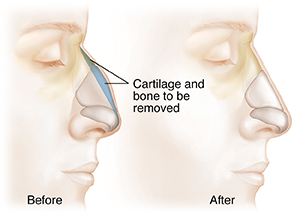A
B
C
D
E
F
G
H
I
J
K
L
M
N
O
P
Q
R
S
T
U
V
W
X
Y
Z
Click a letter to see a list of medical procedures beginning with that letter.
Click 'Back to Intro' to return to the beginning of this section.
Nasal Surgery: Improving the Appearance of Your Nose
Nasal surgery is a surgical procedure aimed at improving the look and function of the nose. It's also called rhinoplasty. Beyond its cosmetic benefits, rhinoplasty can help breathing issues and correct congenital or traumatic nasal deformities. Any surgery to improve the way you look is called aesthetic, plastic, or cosmetic surgery. In most of these surgeries, bone and cartilage in the nose are trimmed and moved.
 |
| During surgery, bone and cartilage are trimmed to reduce the profile of the nose. |
A typical aesthetic problem
What's done during your surgery depends on the type of changes to be made. The nasal bones and the upper and lower cartilage may need to be trimmed. Or they may need to be moved to give your nose the shape you want. Most cuts (incisions) are made inside the nose so the scars won't be seen.
A wide base problem
You may want the base of your nose to be narrowed. To do this, tissue needs to be removed from around the nostrils. Incisions are made on the outside of the nose and some tissue is removed. The tissue is then stitched (sutured) together. The scars will be hidden by the folds of the nostrils.
Risks
As with any surgery, nasal surgery has some risks. Your healthcare provider will discuss risks and complications with you. These may include:
-
A hole in your nasal septum
-
Infections
-
Bleeding in the nose
-
Poor wound healing
-
Skin discoloration
-
Unsatisfactory appearance
-
Pain
-
Scarring
-
Additional surgery
-
Change in the sense of smell
-
Uneven nose
After aesthetic surgery
After aesthetic surgery, you’ll be taken to the postanesthesia care unit (PACU) to be watched as you wake up from the anesthesia. Your experience may be as follows:
-
You’ll have gauze bandages or other material (packing) or a plastic splint inside your nose. This holds the new shape of your nose, prevents bleeding, and promotes healing. You’ll also have a dressing (bandages) and a splint on the outside of your nose. These also help the nose keep its shape as it heals.
-
Expect mucus and some blood to drain through the dressing.
-
You may have swelling or bruising around your eyes.
-
If you have packing, you will have to breathe through your mouth until the packing is removed. This may cause throat dryness and irritation.
-
While healing, be careful not to move your dressing or touch your nose.
-
Pain medicine will be prescribed as needed. Don’t take medicine containing aspirin or ibuprofen. These can increase bleeding.
Follow-up
You’ll need to follow up with your healthcare provider after your surgery. Here's what to expect:
-
Any packing, splint, or dressings will likely be removed. You may feel mild pain and bleed a little when this is done.
-
Expect some numbness, swelling, and nasal congestion.
-
Any bruising and swelling around your eyes and nose will most likely go away in about 3 weeks.
-
If you're told to do compression exercises to help your nose hold its shape, do so only as directed.
Assessing the results
During later follow-up visits, your healthcare provider will assess your healing and your surgery results. It may take 12 to 18 months for your nose to reach its final shape. In most cases, any thick or uneven areas will go away with time. Talk with your healthcare provider about any problems or concerns you may have. In some cases, a second surgery will be needed.
Online Medical Reviewer:
Rita Sather RN
Online Medical Reviewer:
Sabrina Felson MD
Online Medical Reviewer:
Sravani Chintapalli
Date Last Reviewed:
3/1/2024
© 2000-2025 The StayWell Company, LLC. All rights reserved. This information is not intended as a substitute for professional medical care. Always follow your healthcare professional's instructions.